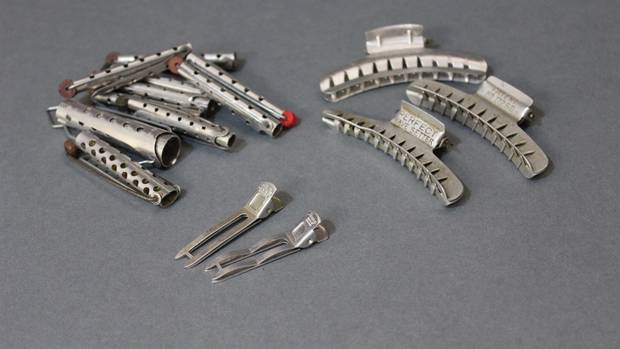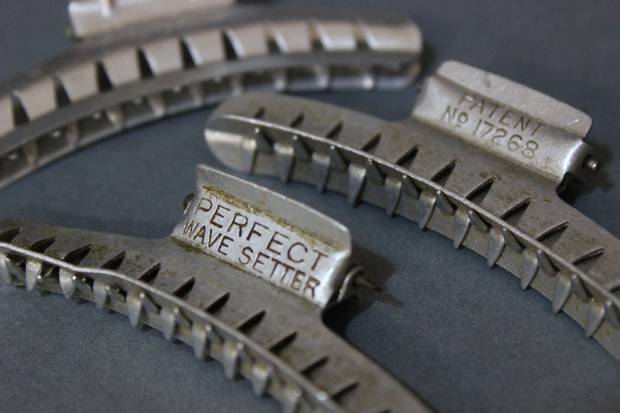Looking at this small collection of metal tools, today's young 'millennials' would struggle to recognise their use. In fact, this odd assortment of small, hinged and rather sharp-looking items are vintage hair clips and tools.

The collection of hair rollers and clips donated by K. Smith at Whangārei Museum (1988.13.12).
Firstly, these clips are all made from metal, rather than the plastic, which most hair accessories are made of today. Secondly, hair styling practices are very different today than 50 years ago.
A total of 42 metal hair clips were donated to Whangārei Museum by KM Smith in 1987, along with several other household items such as pen nibs and ink.
Used for creating specific hairstyles or 'sets', the tools pictured here were each designed to produce specific shapes and patterns in hair, and could be combined to produce all manner of styles.
Hair clasping, cutting, braiding, curling and crimping methods have varied throughout time and across cultures. The extravagant female up-dos of the early 20th century were achieved by drying the hair in curls tied with rags and pinning the resulting brushed-out curls around pieces of padding. Heated curling tongs were also used from the 19th century.
With a growing focus on freedom and ease of life for women during World War I, hairstyles got a lot shorter, with many women cutting their hair into short bobs. These shorter haircuts persevered into the 1950s and the main method of styling them was by pin curling or 'setting'.
Methods range from simple to complicated, and catalogues from the times show different patterns suitable for different hair lengths and social situations.

Clips for setting hair waves (1988.13.12f).
A hair set works best when wet, after washing or by spraying, often including an application of hair-setting lotion.
Rollers, such as those pictured, would help achieve the bouffant looks we often associate with 'retro' and 'vintage' fashions. This is how you achieve the classic 1920s Speakeasy or the 1940s Victory Roll.
It would take one person from 10 minutes to an hour to wind hair sections around rollers and clip them in place using hair clips.
Whangārei Museum's rollers have wires attached, which would clip in place over each hair roll using a small wooden and plastic disc, which you can see in the photo.
The hair would then be set by sleeping in this structure overnight, often held in place with a hair net or scarf, or by sitting under an overhead hair drier in a salon.
I can just imagine Mrs Smith sitting at her dressing table admiring the view over Whangārei Harbour with her hair rollers in and a layer of Ponds cold cream on.
The finishing touch was taking out the rollers and carefully brushing the curls into the desired shapes. Instead of the larger barrel-shaped curls given by rollers, smaller, more-defined pin curls could be achieved using the smaller pin clips, shown in the front, to hold down hand-rolled curls against the head while setting.
More typical of 1930s Hollywood glamour are the nasty-looking saw tooth clips to the right. Their long, curved shapes assisted in crimping horizontal sections of hair to create waves across the surface of the head, rather than curls.
The resulting marcel or finger waves were popular for very short hairstyles during the 1920s and 1930s.
Mid-century hairstyles became softer and longer again, followed by another hair revolution in the 1960s.
Our analysis has only just scratched the surface of 20th-century hair-setting history, but it hopefully highlights the intricate methods behind women's hair and beauty of the past 100 years.
Hair-setting techniques are experiencing a revival and many brands are offering modern versions of these tools with extra parts to make the whole process easier and quicker than in the past.
It is likely that, in another 100 years, the techniques of today will be seeing a revival and reinterpretation.
Georgia Kerby
Exhibitions Curator
4 August 2020